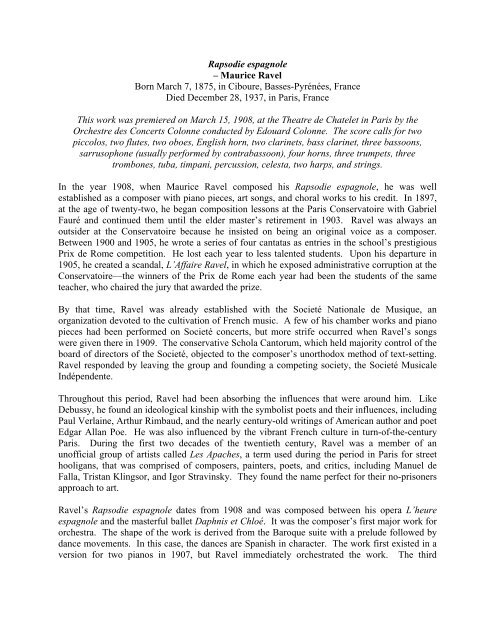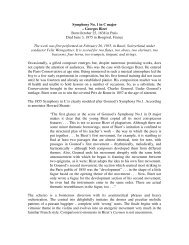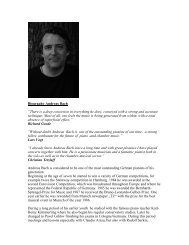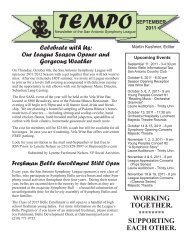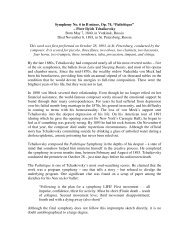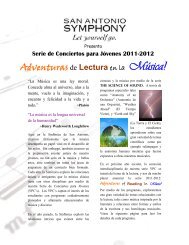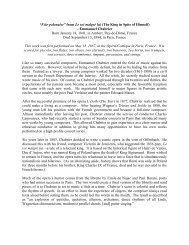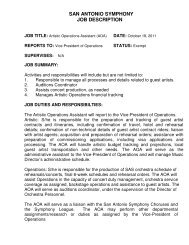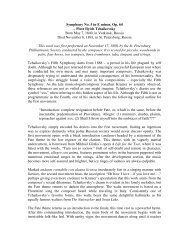Create successful ePaper yourself
Turn your PDF publications into a flip-book with our unique Google optimized e-Paper software.
Rapsodie espagnole<br />
– Maurice Ravel<br />
Born March 7, 1875, in Ciboure, Basses-Pyrénées, France<br />
Died December 28, 1937, in Paris, France<br />
This work was premiered on March 15, 1908, at the Theatre de Chatelet in Paris by the<br />
Orchestre des Concerts Colonne conducted by Edouard Colonne. The score calls for two<br />
piccolos, two flutes, two oboes, English horn, two clarinets, bass clarinet, three bassoons,<br />
sarrusophone (usually performed by contrabassoon), four horns, three trumpets, three<br />
trombones, tuba, timpani, percussion, celesta, two harps, and strings.<br />
In the year 1908, when Maurice Ravel composed his Rapsodie espagnole, he was well<br />
established as a composer with piano pieces, art songs, and choral works to his credit. In 1897,<br />
at the age of twenty-two, he began composition lessons at the Paris Conservatoire with Gabriel<br />
Fauré and continued them until the elder master’s retirement in 1903. Ravel was always an<br />
outsider at the Conservatoire because he insisted on being an original voice as a composer.<br />
Between 1900 and 1905, he wrote a series of four cantatas as entries in the school’s prestigious<br />
Prix de Rome competition. He lost each year to less talented students. Upon his departure in<br />
1905, he created a scandal, L’Affaire Ravel, in which he exposed administrative corruption at the<br />
Conservatoire—the winners of the Prix de Rome each year had been the students of the same<br />
teacher, who chaired the jury that awarded the prize.<br />
By that time, Ravel was already established with the Societé Nationale de Musique, an<br />
organization devoted to the cultivation of French music. A few of his chamber works and piano<br />
pieces had been performed on Societé concerts, but more strife occurred when Ravel’s songs<br />
were given there in 1909. The conservative Schola Cantorum, which held majority control of the<br />
board of directors of the Societé, objected to the composer’s unorthodox method of text-setting.<br />
Ravel responded by leaving the group and founding a competing society, the Societé Musicale<br />
Indépendente.<br />
Throughout this period, Ravel had been absorbing the influences that were around him. Like<br />
Debussy, he found an ideological kinship with the symbolist poets and their influences, including<br />
Paul Verlaine, Arthur Rimbaud, and the nearly century-old writings of American author and poet<br />
Edgar Allan Poe. He was also influenced by the vibrant French culture in turn-of-the-century<br />
Paris. During the first two decades of the twentieth century, Ravel was a member of an<br />
unofficial group of artists called Les Apaches, a term used during the period in Paris for street<br />
hooligans, that was comprised of composers, painters, poets, and critics, including Manuel de<br />
Falla, Tristan Klingsor, and Igor Stravinsky. They found the name perfect for their no-prisoners<br />
approach to art.<br />
Ravel’s Rapsodie espagnole dates from 1908 and was composed between his opera L’heure<br />
espagnole and the masterful ballet Daphnis et Chloé. It was the composer’s first major work for<br />
orchestra. The shape of the work is derived from the Baroque suite with a prelude followed by<br />
dance movements. In this case, the dances are Spanish in character. The work first existed in a<br />
version for two pianos in 1907, but Ravel immediately orchestrated the work. The third
movement, Habanera, was composed in 1895 as the first movement of the Sites auriculaires and<br />
was included in Rapsodie espagnole when the other movements were composed.<br />
The Prélude à la nuit opens with a mysterious four-note descending pattern that conjures images<br />
of the night. In the middle of the movement, two cadenzas are heard—one for two clarinets<br />
followed by one for two bassoons. As if a dream, the music fades away in the final measures.<br />
Malagueña, the second movement, is a tour-de-force of orchestration. A festive celebration<br />
gently disturbs the peace of the night, quietly at first, and then building in fervor until the party is<br />
in full swing. An evocative English horn solo reclaims the nocturnal peacefulness and the<br />
movement ends with a return to sweet slumber.<br />
Spain’s sunny and seductive side comes to life in the third movement, Habanera. Although the<br />
dance originated in Havana, the habanera has become associated with Spain. Bizet chose the<br />
same dance to introduce Carmen to the world. Ravel accentuates the sultry side of the Iberian<br />
Peninsula with conflicting duple and triple rhythms. He inscribed the original 1895 piano<br />
version of this movement with the words “Au pays parfumé que le soleil caresse”—“In the<br />
perfumed land that the sun caresses.”<br />
Ravel’s finale is one of his miniature masterpieces. Feria, or “carnival,” is an energetic<br />
depiction of a Spanish festival. It is difficult to believe, but the composer had never been to<br />
Spain at the time he composed this music. The energy is palpable from the opening measure.<br />
Theme after theme flies by in this orgiastic feast of musical color. Splashes of orchestration<br />
erupt, only to be outdone by another climax. The four-note ‘night’ theme from the prelude<br />
returns, but not even the darkness can stop the carnival. Rapsodie espagnole ends with an<br />
exquisite explosion of orchestra excitement.<br />
©2012 Orpheus Music Prose & Craig Doolin<br />
www.orpheus<strong>notes</strong>.com
Noches en los Jardines de España (Nights in the Gardens of Spain)<br />
– Manuel de Falla y Matheu<br />
Born November 23, 1876, in Cádiz, Spain<br />
Died November 14, 1946, in Alta Gracia, Argentina<br />
This work was premiered on April 9, 1916, in Madrid Spain, by the Madrid Symphony Orchestra<br />
conducted by Enrique Fernández Arbós with pianist José Cubiles. It is scored for solo piano,<br />
piccolo, two flutes, two oboes, English horn, two clarinets, two bassoons, four horns, two<br />
trumpets, three trombones, tuba, timpani, percussion, harp, celesta, piano, and strings.<br />
During a seven-year sojourn in Paris beginning in 1907, Manuel de Falla became acquainted<br />
with the young lions of the musical world – Claude Debussy, Maurice Ravel, and Igor<br />
Stravinsky – and he intended to settle there, but the outbreak of World War I forced him to return<br />
to Spain in 1914. In 1909 Falla began a new work for the pianist Ricardo Viñes. Originally<br />
planned as a set of nocturnes, the piece took on a new life when Viñes and composer Isaac<br />
Albéniz suggested that it should be orchestrated. When Falla returned to Spain, Nights in the<br />
Gardens of Spain had grown to its present form as a three-movement set of “symphonic<br />
impressions” inspired by different Spanish gardens. In fact, the French impressionistic influence<br />
is quite apparent in this work.<br />
Although it is scored for solo piano and orchestra, Nights in the Gardens of Spain is not a<br />
traditional concerto. The solo part, although difficult, is not the primary focus at all times.<br />
Instead, both elements – the solo piano and orchestra – provide two intricate palettes of musical<br />
color that work together to produce a captivating work of scintillating beauty.<br />
The first movement, En el Generalife (In the Generalife), evokes the garden of a fourteenthcentury<br />
Moorish palace in Grenada, where cypresses and walnut trees rose above terraced<br />
gardens. Piano arpeggios throughout the movement waft over the lush orchestra texture in an<br />
atmospheric wash of color.<br />
Although the second movement, Danza lejana (Distant Dance), names no specific garden, the<br />
effect is Moorish-flavored. Violas, English horn, and flutes set the exotic tone, but soon give<br />
way to the full orchestra. The soloist rises to the surface and presents a rhythmic theme of<br />
simple beauty. Oboes and English horn return with an extended version of the theme. As the<br />
movement ends, the music becomes more subdued and moves without pause into the finale.<br />
En los jardines de la Sierra de Córdoba (In the Gardens of the Sierra de Córdoba), depicts the<br />
dancing of gypsies at the feast of Corpus Christi. At the outset, the full orchestra erupts in a<br />
blaze of Andalusian dance music. The soloist has a much more virtuosic role and introduces<br />
much of the thematic material. Boisterous moments alternate with more lyrical interludes.<br />
Unlike most works featuring a soloist, this evocative and impressionist masterwork ends with a<br />
subdued and transcendent coda, in which the strings reach ever upward as they fade into the<br />
distance.<br />
©2012 Orpheus Music Prose & Craig Doolin<br />
www.orpheus<strong>notes</strong>.com
Nocturnes<br />
– Claude Debussy<br />
Born August 22, 1862, in St. Germain-en-Laye, France<br />
Died March 25, 1918, in Paris, France<br />
The first two movements of this work were first performed on December 9, 1900, in Paris. The<br />
entire work was given, as a whole, for the first time on October 27, 1901, in Paris. It is scored<br />
for three flutes, two oboes, English horn, two clarinets, three bassoons, four horns, three<br />
trumpets, three trombones, tuba, percussion, two harps, female chorus, and strings.<br />
In the late nineteenth century, the music of Richard Wagner was generally regarded as the<br />
newest and most progressive in Europe. In Vienna, Paris, and a few other cities, a younger<br />
generation of composers began to write in reaction to Wagner’s music – some following his<br />
model, and others rejecting it and producing newer styles. One of the newer fashions in music<br />
was that of Impressionism. There is a dream-like atmosphere, loose flowing rhythms, diffuse<br />
textures, and mysterious tone colors.<br />
The first composer to gain prominence writing in this style was Claude Debussy. However, he<br />
should not be grouped solely with the Impressionists. Debussy had a varied career, beginning<br />
with his admission to the Paris Conservatoire at the age of ten, in lieu of ordinary school. His<br />
first compositions date from seven years later when he began to write art songs. Soon afterward,<br />
he was hired as a tutor by Nadezhda von Meck, the wealthy widow who became Tchaikovsky’s<br />
patroness shortly thereafter. After returning from Russia, Debussy found a mentor in famous<br />
French Charles Gounod. After winning the coveted Prix de Rome in 1884 for his dramatic<br />
cantata L’enfant prodigue (The Prodigal Son), he was on the course for an illustrious career as a<br />
composer. Debussy composed piano pieces, art song, and opera, constantly searching for new<br />
methods of depicting the texts and vast varieties of images associated with his numerous<br />
compositions.<br />
It seems only natural that Debussy and his followers would have been drawn to the placid, often<br />
dream-like, nocturne as made popular in the 1830s and 1840s in the salon works of Frederic<br />
Chopin. The subdued hues of the night suited Debussy’s music well – one might recall his Clair<br />
de lune. In 1892 he composed an orchestral work entitled Trois Scènes au Crépuscule (Three<br />
Twilight Scenes) and reworked it into a violin concerto two years later. Both works are now<br />
lost, but only a small degree of speculation is needed to understand the link between these night<br />
pieces and the three-movement orchestra work that Debussy was to compose in 1899 – his<br />
evocative Nocturnes. Debussy described the work as “a study in gray painting” – a statement<br />
that immediately brings to mind the work of American artist James McNeill Whistler, who spent<br />
his creative life in Europe and lived in Paris from 1890 until his death in 1903. Whistler’s<br />
monochrome paintings often bore musical titles (Arrangement in Black and Gray, Symphony in<br />
White, and Harmony in Blue and Silver are but a few of his works).<br />
Set in three movements, Nocturnes examines three distinct facets of the night. For the first<br />
complete performance on October 27, 1901, Debussy wrote a colorful description of his music.
“The title Nocturnes must be taken here in a general, and more particularly, decorative<br />
sense. These are not nocturnes in the usual musical meaning of the word, but rather<br />
nocturnes with respect to all the various impressions and the special effects of light that<br />
the word suggests.<br />
“Nuages (Clouds) renders the immutable sky and the slow, solemn motion of the clouds,<br />
fading away in shades of gray, lightly tinged with white.<br />
“Fêtes (Festivals) portrays the restless dancing rhythms of the night sky, interspersed<br />
with sudden flashes of light; the episode of the procession--a dazzling and fantastic<br />
vision--passes through the festival, becoming a part of it. But the background remains<br />
persistently the same: the festival, its mixture of music and luminous dust, participating<br />
in cosmic rhythms.<br />
“Sirenes (Sirens) depicts the sea and its innumerable rhythm. Amid the waves, turned to<br />
silver by the moon, we hear the mysterious song of the Sirens, laughing and fading<br />
away.”<br />
©2011 Orpheus Music Prose & Craig Doolin<br />
www.orpheus<strong>notes</strong>.com
Bolero<br />
– Maurice Ravel<br />
Born March 7, 1875, in Ciboure, Basses-Pyrénées, France<br />
Died December 28, 1937, in Paris, France<br />
This work was first performed on November 22, 1928, at the Paris Opéra, with Walter Staram<br />
conducting. It is scored for piccolo, two flutes, two oboes, English horn, oboe d’amore, E-flat<br />
clarinet, three clarinets, bass clarinet, two bassoons, contrabassoon, three saxophones<br />
(sopranino, soprano, and tenor), four horns, four trumpets (including one piccolo trumpet), three<br />
trombones, tuba, timpani, percussion, harp, celesta, and strings.<br />
Maurice Ravel was born thirteen years after Claude Debussy but, despite ardent admiration for<br />
his elder colleague’s music, followed his own path. His dealings with authority figures were<br />
never pleasant, as Ravel worked at his own pace, not conforming to deadlines set by others.<br />
Having entered the Paris Conservatoire at age fourteen, he would be dismissed from the<br />
institution three times before ending his quest for a degree. Students were required to win the<br />
school’s competitions in order to gain approval for further studies. First as a pianist, then as a<br />
composer, Ravel failed to win. Then in 1905, upon reaching the thirty year age limit for<br />
competing, he was eliminated in the first round.<br />
By this time in his career, he was already active with the Société Nationale de Musique, having<br />
composed several works that still appear on concerts. As unseemly as it might be, all of the<br />
finalists were students of the same teacher, who also served as a judge. In what was called the<br />
Affaire Ravel, the French newspapers published reports of these new indiscretions at the<br />
Conservatoire, forcing the resignation of the director, and placing Gabriel Faure at the school’s<br />
helm.<br />
Ravel’s interest in American jazz led to a deep friendship with George Gershwin, wo famously<br />
treated him to several nights of jazz sessions in Harlem during a 1928 trip to the United States.<br />
The impact of this experience was profound, and is apparent in several works, including the<br />
ballet Bolero from 1928 and the two piano concertos he composed in 1929 and 1930.<br />
Another influential factor in Ravel’s life at the time was the unfortunate onset of Pick’s disease,<br />
a degenerative brain disorder that first affected the composer in 1927 at the relatively young age<br />
of fifty-two. By 1929 he first noticed muscle control problems and aphasia (difficulty with<br />
language, affecting reading, writing, and speaking). By the mid-1930s Ravel was unable to<br />
communicate at all. He died in 1937 after an unsuccessful attempt to correct his disease through<br />
surgery.<br />
Just before the American tour, Ravel was approached by the famed Russian dancer Ida<br />
Rubinstein about composing a new work for her to premiere. He first thought of making a quick<br />
arrangement of music from Iberia by Spanish composer Isaac Albéniz, but he could not obtain<br />
the rights. As a replacement, Ravel eventually decided upon an experimental approach. He
would write an insistent melody and repeat it unchanged many times while making colorful<br />
adaptations to the orchestration. Through this technique, he would be able to keep the interest of<br />
the listener and allow for Bronislava Nijinska, Rubinstein’s choreographer and sister of Vaclav<br />
Nijinski, to create an exciting staging. At first he called the work Fandango, but changed the<br />
title to Bolero before the premiere.<br />
Ravel was true to his concept, and described his piece as,<br />
“. . . consisting wholly of orchestral tissue without music — of one very long, very<br />
gradual crescendo. The themes are impersonal — folk tunes of the usual Spanish-Arabian<br />
kind.”<br />
The result is much more thrilling than Ravel would have us believe. Bolero begins almost<br />
inaudibly with its signature rhythm played by the snare drum. Layered onto the texture is also a<br />
harmonic pattern – little more than a slow rhythmic C major arpeggio – that acts as a foundation<br />
upon which the work’s melody is constructed. However, the heart of this work is the melody,<br />
first introduced in the low register of the flute. As the piece advances, this tune passes from one<br />
instrument to the next until it moves throughout the orchestra. Often it is presented by small<br />
groups of instruments playing simultaneous harmonizations of the theme – one of these is a<br />
convincing imitation of a steam calliope, the characteristic organ used in circuses. Meanwhile,<br />
the rhythmic and harmonic elements begin a crescendo that progresses through the entire length<br />
of the work, an effect achieved by the gradual addition of instruments. Near the end, the<br />
hypnotic atmosphere is broken by a sudden transition from the C major tonality that has been<br />
present for about fifteen minutes to a bright E major chord that is breathtaking in its simplistic<br />
grandeur. The masterful and climactic coda returns to C major with brusque horn calls outlining<br />
the interval of a tritone. Bolero ends in an unforgettably brilliant blaze of Spanish<br />
incandescence.<br />
©2012 Orpheus Music Prose & Craig Doolin<br />
www.orpheus<strong>notes</strong>.com


